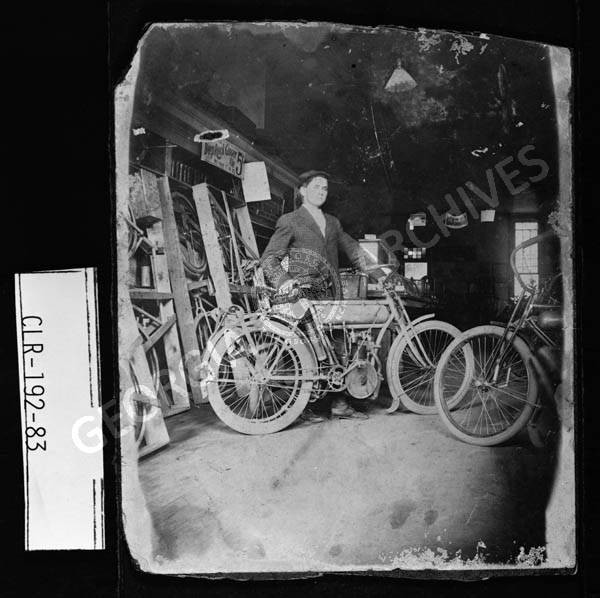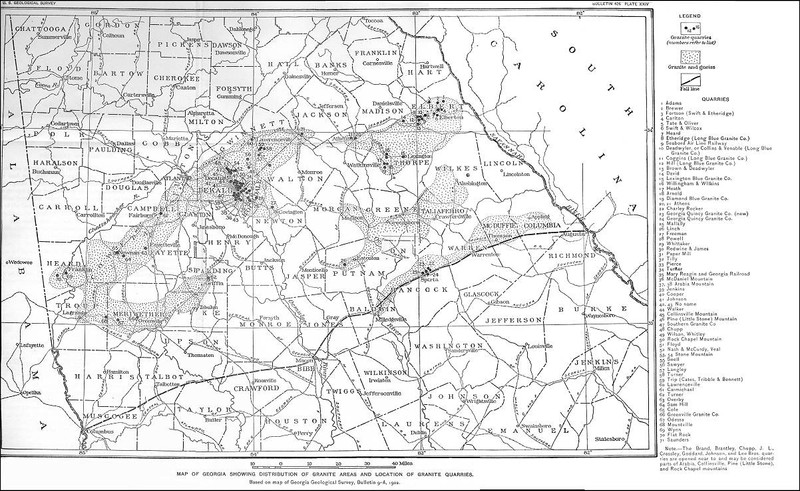Waddell Quarry
Introduction
Text-to-speech Audio
The Waddell street quarry site represents the history of urban development and convict labor in Athens, Georgia. Here at the intersection of Waddell Street and South Newton Street, the land slopes downward on either side. This large depression in the ground marks the approximate location of the Waddell Quarry, which first opened in 1899. A quarry is an excavation or a pit in the ground from which building materials are obtained by cutting or blasting stone from the ground. This particular quarry was used to obtain the building material for the first paved roads in Athens. The city engineer at the time, J.W. Barnett, likely leased convict laborers from the notorious Colonel James Smith of Smithonia to build these roads. Convict labor was a labor system in which the state and counties sold the work of convicted criminals to landowners and local governments for farms, roads, mines, railroads and other projects. The first convict labor transaction occurred in Georgia in 1868 and the system of renting convicts to private employers lasted until 1908 when progressive legislation outlawed the practice because of inhumane treatment. States and counties continued to use convict labor on public projects and often still do.
Images
Photograph of rock crusher (or steam roller) at the Athens Rock Quarry, Athens, Clarke County, Georgia 1900.

Photograph of man who may be Ben Epps with a motorcycle built by him, Athens, Clarke County, Georgia, ca. 1900-1910

Map of Georgia Showing Distribution of Granite Areas and Location of Granite Quarries (circa 1902)

Backstory and Context
Text-to-speech Audio
If you have ever biked, run, or walked the streets of Athens, Georgia, then you will remember the intimidating collection of hills that sprinkle the city. Not all of these hills are natural to the area. Some of these hills resulted from man-made construction and land development. Hills and roads in Athens provide evidence of the violent history of convict labor lurking beneath the surface of this mid-sized college town. Near the intersection of Waddell Street and South Newton Street, the land slopes downward on either side. These slopes create two more hills in the neighborhood. This large depression in the ground marks the approximate location of the Waddell Quarry, which first opened in 1899. Today, the Special Collections Library of Georgia, the Weir Neighborhood and a Holiday Inn Express cover the partially-filled quarry. A quarry is an excavation or a pit in the ground from which building materials are obtained by cutting or blasting stone from the ground. This particular quarry was used to obtain the building material for the first paved roads in Athens. The Waddell street quarry site marks both the history of urban development and the exploitation of convict laborers during the early twentieth century.
The Convict Lease System originated in Reconstruction-era politics. After 1864, many newly freed Black men and women traveled around the South to locate family members who had been sold away. Some freed people trickled North. Black women and children also left the cotton fields and took up domestic work. This movement of freed laborers sparked a labor shortage or at least the perception of one. Perceived idleness and vagrancy confirmed white southerners' racist views that Black men and women were ill-suited to the free labor system. White southern landowners and northern legislators disagreed sharply on the question of how to obtain workers for large labor intensive farms, railroads, and public works projects. The terms of Reconstruction required southern representatives to approve the fourteenth amendment which guaranteed citizenship, equal protections of the law, and due process of the law to anyone born in the United States, except for those convict of crimes. Convicts could still be forced to work. John Ditmer, a historian of African American southerners, argue that the absence of “the economic value of slaves as property” increased the abuse of Black workers. Convicts were the most expendable of all. The reconstructed South maintained a form of coerced labor through the convict lease system.
The majority of these convicted criminals would have been Black men, and far less often Black women, charged with vagrancy and other misdemeanors. White people were also leased under the convict lease system but much less often, even though they represented the majority of the population across the South. This system, which began at a time when there were few prisons in the South, morphed into a money-making enterprise, which generated significant revenue for states, counties, public officials, and contractors. In Georgia, the first convicts were leased to private companies in 1868. Georgia leased many convicts to the notorious Colonel James Smith of Smithonia, who owned the largest farm in the state. Smith's convict camps were rumored to have terrible living conditions. Dr. Willis F. Westmoreland, the Principle Physician of the Penitentiary, recorded an outbreak of measles and evidence of scurvy in 1883. Laborers were frequently whipped and dogs were kept on the property to hunt down escapees.
This system lasted until 1908 when progressive legislation outlawed the practice because of inhumane treatment and the competition unpaid convicts posed to free white workers. Convict labor didn't end, however. States and counties continued to use convicts' labor legally and most still do. These public workers were often referred to as "chain gangs" because prisoners were often shackled together as they worked. Chain gangs replaced the convict lease system as a result of calls for reform, but often included the same standards of mistreatment.
During the later years of the 19th century, transportation within the city of Athens relied on electric-powered, horse-powered, and mule-powered street cars. Mr. Snodgrass, a business entrepreneur from Texas, chartered the Classic City Street Railway Company in 1885. Mules pulled street cars on rails laid down on Broad, College, Clayton, Lumpkin, Hancock, Pulaski, Prince and Milledge street. Messrs. E. G. Harris and John T. Voss obtained the company in 1891 and converted the line to electric power. Townspeople continued to travel by foot and horse as well. However, if it rained these options were less reliable. Pavement enabled the townspeople of Athens to travel to work and school more consistently. The first paved road in Athens, a section of Broad street leading towards Oconee River, was paved in 1885 in Belgian block. This material provided a better grip for horses on steep slopes. City ordinances in 1889 required sidewalks within the fire limits of the city. A “bicycle craze” among wealthy white Athenians occurred in 1893. A few Athenians even built their own bikes. Automobiles were becoming more common into the twentieth century. Bikes and automobiles often collided on unpaved roads. These biking accidents motivated city officials to authorize the paving of more roads in Athens. These roads were paved with macadam pavement which consisted of crushed granite rock rolled onto streets. Significant manual labor would have been required to crush the granite and operate the new equipment.
In 1899, the city enlisted J.W. Barnett as city engineer to pave the streets. Barnett purchased a steam roller or rock crusher to expedite the task of crushing gravel into the roads but convicts would have quarried the rock and paved the roads the steam roller had flattened. The Athens Electric Railway Track stopped inside the quarry to deliver tools and convict workers. The quarry remained in operation until 1904, when nearby residents complained about dynamite blasting. A new quarry opened on Judge Hamilton McWhorter’s property west of Milledge street in 1906 and remained in operation until 1909. By 1914, convict chain gangs had paved 57.2% of local roads.
Though Black people did the work of paving the roads, urban development in Athens bypassed Black neighborhoods. In 1909, 30.6% of Clarke County roads were paved, but roads to African American Athenian neighborhoods in East Athens were not paved until 1967, when the federally funded Model Cities program finally paid for the work to be done.
Sources
Bailey, Fred A. "E. Merton Coulter (1890-1981)." New Georgia Encyclopedia. August 5, 2015. Web. (accessed October 16, 2019).
Bragg, William H. "Reconstruction in Georgia." New Georgia Encyclopedia. October, 14 2019. Web. (accessed October 16 2019).
Cullison, Jr. David Charles. “Streets and Pavements,” in J.W. Barnett The Influence of the Architect and City Engineer on the Physical Development of Athens, Georgia 1889 - 1930 University of Georgia, 1995.
Cohen, William. At Freedom's Edge : Black Mobility and the Southern White Quest for Racial Control, 1861-1915. Baton Rouge: Louisiana State University Press, 1991.
Coulter, E. Merton. James Monroe Smith, Georgia Planter, before Death and After. Athens, Georgia: University of Georgia Press. 1961.
Ray, David Winter. A History of Streetcar Service in Athens, Georgia, and Some Possibilities for Its Reintroduction. Athens, Georgia: University of Georgia Masters of Historic Preservation. 2005.
Dittmer, John. Black Georgia in the Progressive Era 1900-1920. Urbana, Illinois: University of Illinois Press. 1939.
Engerrand, Steven W. "Now Scratch or Die” : The Genesis of Capitalistic Agricultural Labor in Georgia, 1865-1880. 1981.
Georgia Archives. “Photograph of rock crusher at the Athens Rock Quarry, Athens, Clarke County, Georgia 1900.” 1900. October 18, 2019. http://dlg.galileo.usg.edu/vang/id:clr097.
Lichtenstein, Alex. "Good Roads and Chain Gangs in the Progressive South: "The Negro Convict Is a Slave". The Journal of Southern History 59, no. 1 (1993): 85-110. doi:10.2307/2210349.
Taylor, A. Elizabeth. The Origin and Development of the Convict Lease System in Georgia. Savannah, 1942.
Taylor, A. Elizabeth. The Abolition of the Convict Lease System in Georgia. Savannah, 1942.
Thompson, C. Mildred. Reconstruction in Georgia. Freeport, New York: Books for Libraries Press. 1915.
Todd, William A. "Convict Lease System." New Georgia Encyclopedia. 13 May 2019. Web. 06 November 2019.
Whitlock, Beth (Finding Aid Author) “Stockade” (page 9 of 1948 Athens City Engineers Report) Athens City Engineers Collection Misc. Box 10 Folder 54. Athens-Clarke County LibraryHeritage Room. MSS 056. 2018.
Vanishing Georgia, Photograph of who may be Ben Epps with a motorcycle. Georgia Archives, Morrow, Georgia. 1900-1910.
Georgia Archives. “Photograph of rock crusher at the Athens Rock Quarry, Athens, Clarke County, Georgia 1900.” 1900. October 18, 2019. http://dlg.galileo.usg.edu/vang/id:clr097.
Vanishing Georgia, Georgia Archives, University System of Georgia
From Granites of the Southeastern Atlantic States, Bulletin 426, 1910. Based on map of Georgia Geological Survey, Bulletin 9-A, 1902. Plate XXIV
